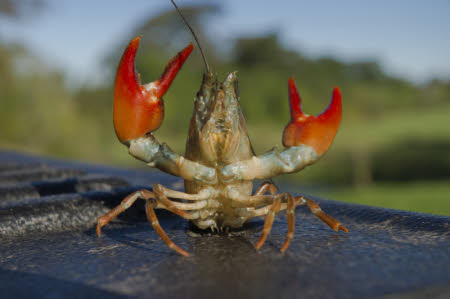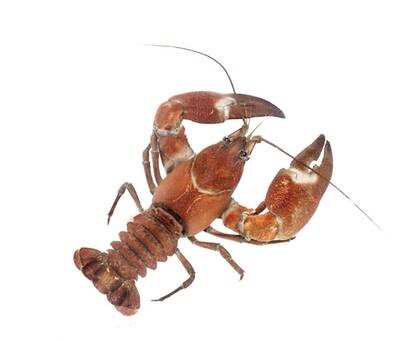Crayfish are an invertebrate species, lacking a backbone or bony skeleton but instead are generally soft bodied animals with a hard outer skeleton. Being a species of invertebrate called arthropods, crayfish are characterised by a joined head, mid-section and segmented body with four pairs of legs used to move and circulate water for respiration. An additional pair of legs at the front of the body have powerful pincers called chelae, which are used for feeding, defence and courtship.
Most commonly found in rivers and lakes, crayfish choose to hide under rocks and material along the riverbed. They then emerge at night to hunt and feed on insects and tadpoles through their habitat. Making them a key part of food chains by supporting birds, fish and other vertebrates.
Most crayfish species prefer to live in freshwater, although a few species are able to survive in brackish or salt water. Their surrounding environment is very important not only for its quality but also for its supply of minerals. Did you know crayfish take calcium from the environment to produce stones of it in their stomach, which are then stored and reabsorbed when they need to form a new shell?
Worldwide there are over 500 species, more than half of which live in North America. The UK is home to just seven of these species with only one native species called the White Clawed Crayfish. Varying in size and shape some of these crayfish can grow up to 16cm long and have different sized and shaped claws. Most of these non-native species were introduced for food or angling bait but then escaped into the wild, causing damage to the environment and native species. In order to try and combat these non-native species introductions, the Wildlife and Countryside Act, 1981, is used to protect native animals and prevent any further release of non-native species.
White Clawed Crayfish
The White Clawed Crayfish is a brown olive coloured native freshwater crustacean with a pale underside on its claws, giving its name ‘white clawed’.
Once widespread across England and Wales, they are now only found in fragmented patches across the UK. This highlights the importance of it’s presence along the river Witham as one of the last strongholds for the species in the UK.
Their presence is a good indicator of high water quality as they are intolerant of pollution. However, they also contribute to the quality of an ecosystem through their role in freshwater food chains. They help connect the food chain, having an omnivorous diet of invertebrates, carrion and water plants, and acting as a food source for higher predators such as fish, herons and otters.

These nocturnal crayfish prefer to live in habitats that have places to hide such as woody material, submerged vegetation, gravels and even man made material. They forage for food between June and November before the water temperature drops in November when they will reproduce. They then carry the eggs for 9 months until they hatch in June. Did you know that juvenile crayifsh stay with their mothers, catching a ride on their backs for up to two weeks before searching for their own shelter?
Although White Clawed Crayfish are the only native crayfish species to the UK there are six species of non-native crayfish. One of which is the American Signal Crayfish which heavily preys on the native species. Introduced in the 1970s, these crayfish carry and spread a disease deadly to White Clawed Crayfish, which is still an ongoing threat, causing a massive decline in numbers. Especially as this plague can be spread not only by Signal Crayfish, but also by water, fish or equipment that has been in contact with them. Not only do Signal Crayfish form a threat through this plague, they also predate and outcompete the native species, being larger and more aggressive.
As they are a declining species, dwindling in population numbers, White Clawed Crayfish are a protected species under Environmental Law. Therefore, making their removal illegal without a proper license.
Under these laws, White Clawed Crayfish are:
- A protected species under the Wildlife and Countryside Act, 1981.
- An endangered species on the International Union for Conservation of Nature (ICUN) Red list of threatened species.
Signal Crayfish

Signal crayfish are the most abundant invasive, non-native crayfish species in the UK. They look similar to White Clawed Crayfish but are generally bigger and have red undersides to their claws compared to the white undersides of the native species.
This crayfish oringinated in North America and was introduced to the UK in the 1970s because
their larger size made them a more desirable seafood.
Multiple factors enable these American crayfish to outcompete the native species. Not only are they bigger, they are able to survive in lower quality conditions and carry a plague that kills the White Clawed Crayfish. Making it easy for them to take food and shelter from the smaller species. Unlike the native crayfish they are also active during daylight hours, giving them another competitive edge. Did you know that, in a mixed crayfish habitat, it takes an estimated three to five years for Signal Crayfish to completely eliminante the White Clawed Crayfish population?

In addition to being detriminental to our native crayfish, the Signal Crayfish also have a huge impact on other freshwater species through predation and competition, as well adding unwanted sediment to the river through burrowing.
They are listed as a Schedule 9 species under Section 14 of the Wildlife and Countryside Act, 1981. Which lists established non-native species that represent a threat to the natural fauna and flora. This section of the act prohibits the release of any of the species listed in schedule 9.






